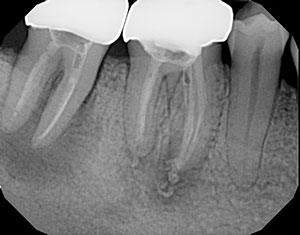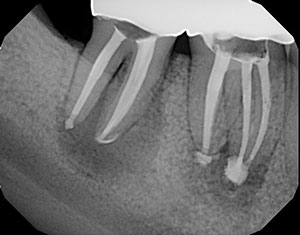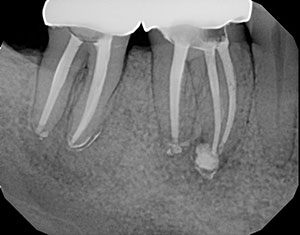
A patient had root canals performed by her dentist 6 months ago. She said her teeth still didn’t feel right, and she didn’t want them to be extracted and replaced with implants. She flared up with pain, and her dentist referred her to me.
The previous root canals were performed on teeth No. 30 and 31. Many clinicians would have thought that tooth No. 31 had a vertical root fracture due to the breakdown in the furcation. The diagnosis was previously treated teeth with acute apical periodontitis.
 |
 |
|
Figure 2. Retreatment began with calcium hydroxide placed in both teeth. |
Figure 3. The root canal was completed on both teeth using bioceramic sealer. |
 |
|
Figure 4. The six-month recall showed nice healing on both teeth taking place. |
I retreated both teeth, and calcium hydroxide was placed for 2 weeks. The patient returned, and both teeth were obturated with EndoSequence BC Sealer by Brasseler USA and standard gutta-percha. This is considered a “single cone” technique. The patient returned in 6 months with remarkable healing.
Do you know why this case failed to heal after its previous treatment?
#RelaxDontExtract
Dr. Short attended the Medical College of Georgia (MCG) School of Dentistry to attain a DMD degree in 1999. In 2002, he earned his postdoctorate degree in endodontics from Nova Southeastern University and then became a Diplomate of the American Board of Endodontics in 2009. Dr. Short is an expert consultant in endodontics to the Georgia Board of Dentistry and assistant clinical professor at the Dental College of Georgia in Augusta. He is endorsed by the American Association of Endodontists speakers bureau. His private practice, Apex Endodontics PC, is located in Smryna, Ga. Dr. Short also has authored a book, Getting to the Root of Your Problem: 365 Days of Inspirational Thinking. He can be reached at dr.short@yahoo.com.
Related Articles
A Short Case Study: A Root Canal Trifecta


